Testing Machine Learning and Traditional Models for Tree-Ring-Based scPDSI Streamflow Reconstruction: A 1500-Year Record of the French Broad River, Tennessee, USA
Abstract
1. Introduction
2. Materials and Methods
2.1. Study Area
2.2. Streamflow Reconstruction
2.3. Sensitivity Analyses
2.4. Trend Analysis
3. Results
3.1. Modeled Streamflow Reconstruction
3.2. Temporal Characteristics of Streamflow
4. Discussion
4.1. Sensitivity Analyses of Reconstruction Approaches
4.2. Long-Term Flow Trends
5. Conclusions
Supplementary Materials
Author Contributions
Funding
Data Availability Statement
Acknowledgments
Conflicts of Interest
Abbreviations
| CE | Common Era |
| DL | Deep Learning |
| GLM | Generalized Linear Model |
| km2 | Square kilometers |
| m3 | Cubic meters |
| MCM | Million cubic meters |
| ML | Machine Learning |
| PDSI | Palmer Drought Severity Index |
| R | R statistical computing environment/language |
| R2 | Model decimal proportion of variance explained |
| r2 | Squared Pearson’s correlation |
| RF | Random Forest |
| RMSE | Root-mean-square error |
| scPDSI | Self-calibrating Palmer Drought Severity Index |
| SLR | Stepwise Linear Regression |
| TVA | Tennessee Valley Authority |
| U.S. | United States |
| USGS | United States Geological Survey |
| VIF | Variance Inflation Factor |
| yr | Year |
References
- Meko, D.M.; Woodhouse, C.A. Application of streamflow reconstruction to water resources management. In Dendroclimatology: Progress and Prospects; Hughes, M.K., Swetnam, T.W., Diaz, H.F., Eds.; Springer: Dordrecht, The Netherlands, 2010; pp. 231–261. [Google Scholar]
- Meko, D.M.; Woodhouse, C.A.; Morino, K. Dendrochronology and links to streamflow. J. Hydrol. 2012, 412, 200–209. [Google Scholar] [CrossRef]
- Guiterman, C.H.; Gille, E.; Shepherd, E.; McNeill, S.; Payne, C.R.; Morrill, C. The International Tree-Ring Data Bank at fifty: Status of stewardship for future scientific discovery. Tree-Ring Res. 2024, 80, 13–18. [Google Scholar] [CrossRef]
- Stahle, D.W.; Cook, E.R.; Burnette, D.J.; Torbenson, M.C.; Howard, I.M.; Griffin, D.; Diaz, J.V.; Cook, B.I.; Williams, A.P.; Watson, E.; et al. Dynamics, variability, and change in seasonal precipitation reconstructions for North America. J. Clim. 2020, 33, 3173–3195. [Google Scholar] [CrossRef]
- Cook, E.R.; Seager, R.; Heim, R.R., Jr.; Vose, R.S.; Herweijer, C.; Woodhouse, C. Megadroughts in North America: Placing IPCC projections of hydroclimatic change in a long-term palaeoclimate context. J. Quat. Sci. 2010, 25, 48–61. [Google Scholar] [CrossRef]
- Cook, E.R.; Seager, R.; Kushnir, Y.; Briffa, K.R.; Büntgen, U.; Frank, D.; Krusic, P.J.; Tegel, W.; van der Schrier, G.; Andreu-Hayles, L.; et al. Old World megadroughts and pluvials during the Common Era. Sci. Adv. 2015, 1, e1500561. [Google Scholar] [CrossRef]
- Ho, M.; Lall, U.; Cook, E.R. Can a paleodrought record be used to reconstruct streamflow? A case study for the Missouri River Basin. Water Resour. Res. 2016, 52, 5195–5212. [Google Scholar] [CrossRef]
- Woodhouse, C.A. Artificial neural networks and dendroclimatic reconstructions: An example from the Front Range, Colorado, USA. Holocene 1999, 9, 521–529. [Google Scholar] [CrossRef]
- Gangopadhyay, S.; Harding, B.L.; Rajagopalan, B.; Lukas, J.J.; Fulp, T.J. A nonparametric approach for paleohydrologic reconstruction of annual streamflow ensembles. Water Resour. Res. 2009, 45, 1653–1659. [Google Scholar] [CrossRef]
- Li, J.; Wang, Z.; Lai, C.; Zhang, Z. Tree-ring-width based streamflow reconstruction based on the random forest algorithm for the source region of the Yangtze River, China. Catena 2019, 183, 104216. [Google Scholar] [CrossRef]
- Jevšenak, J.; Levanič, T. Should artificial neural networks replace linear models in tree-ring based climate reconstructions? Dendrochronologia 2016, 40, 102–109. [Google Scholar] [CrossRef]
- Jevšenak, J.; Levanič, T.; Džeroski, S. Comparison of an optimal regression method for climate reconstruction with the compare_methods() function from the dendroTools R package. Dendrochronologia 2018, 52, 96–104. [Google Scholar] [CrossRef]
- Anderson, S.; Ogle, R.; Tootle, G.; Oubeidillah, A. Tree-ring reconstructions of streamflow for the Tennessee Valley. Hydrology 2019, 6, 34. [Google Scholar] [CrossRef]
- Colquhoun, D.J.; Friddell, M.S.; Wheeler, W.H.; Daniels, R.B.; Gregory, J.P.; Miller, R.A.; Van Nostrand, A.K. Quaternary Geologic Map of the Savannah 4° × 6° Quadrangle, United States; U.S. Geological Survey Miscellaneous Investigations Series Map I–1420 (NI–17); U.S. Geological Survey: Reston, VA, USA, 1987; scale 1:1,000,000.
- Schaefer, M.; Barker, B.; Carney, S.; Gibson, W.; Martin, D.; Parzybok, T.; Taylor, G. Regional Precipitation-Frequency Analyses for Mid-Latitude Cyclones, Mesoscale Storms with Embedded Convection, Local Storms and Tropical Storm Remnant Storm Types in the Tennessee Valley Watershed; Report to Tennessee Valley Authority, 2015. Available online: https://mgsengr.com/wp-content/download/TVA_Point%20Precipitation-Frequency_2015-03-02_Release.pdf (accessed on 5 October 2025).
- Jones, J.R.; Schwartz, J.S.; Ellis, K.N.; Hathaway, J.M.; Jawdy, C.M. Temporal variability of precipitation in the Upper Tennessee Valley. J. Hydrol. Reg. Stud. 2015, 3, 125–138. [Google Scholar] [CrossRef]
- Li, W.; Li, L.; Fu, R.; Deng, Y.; Wang, H. Changes to the North Atlantic subtropical high and its role in the intensification of summer rainfall variability in the southeastern United States. J. Clim. 2011, 24, 1499–1506. [Google Scholar] [CrossRef]
- Cook, E.R.; Lall, U.; Woodhouse, C.A.; Meko, D.M. NOAA/WDS Paleoclimatology—Cook et al. 2004 North American Drought Atlas PDSI Reconstructions; NOAA National Centers for Environmental Information: Boulder, CO, USA, 2005. [CrossRef]
- Robeson, S.M.; Maxwell, J.T.; Ficklin, D.L. Bias correction of paleoclimatic reconstructions: A new look at 1200+ years of Upper Colorado River flow. Geophys. Res. Lett. 2020, 47, e2019GL086689. [Google Scholar] [CrossRef]
- Ramírez Molina, A.A.; Tootle, G.; Formetta, G.; Piechota, T.; Gong, J. Extraordinary 21st Century Drought in the Po River Basin (Italy). Hydrology 2024, 11, 219. [Google Scholar] [CrossRef]
- Pohlert, T. trend: Non-Parametric Trend Tests and Change-Point Detection; R Package v1.4; 2023; Available online: https://brieger.esalq.usp.br/CRAN/web/packages/trend/vignettes/trend.pdf (accessed on 5 October 2025). [CrossRef]
- R Core Team. R: A Language and Environment for Statistical Computing; R Foundation for Statistical Computing: Vienna, Austria, 2024; Available online: https://www.R-project.org/ (accessed on 5 October 2025).
- Mallakpour, I.; Villarini, G. A simulation study to examine the sensitivity of the Pettitt test to detect abrupt changes in mean. Hydrol. Sci. J. 2016, 61, 245–254. [Google Scholar] [CrossRef]
- Ryberg, K.R.; Hodgkins, G.A.; Dudley, R.W. Change points in annual peak streamflows: Method comparisons and historical change points in the United States. J. Hydrol. 2020, 583, 124307. [Google Scholar] [CrossRef]
- Hodgkins, G.A.; Over, T.M.; Dudley, R.W.; Russell, A.M.; LaFontaine, J.H. The consequences of neglecting reservoir storage in national-scale hydrologic models: An appraisal of key streamflow statistics. JAWRA J. Am. Water Resour. Assoc. 2024, 60, 110–131. [Google Scholar] [CrossRef]
- Fang, K.; Kifer, D.; Lawson, K.; Feng, D.; Shen, C. The data synergy effects of time-series deep learning models in hydrology. Water Resour. Res. 2022, 58, e2021WR029583. [Google Scholar] [CrossRef]
- Xu, T.; Liang, F. Machine learning for hydrologic sciences: An introductory overview. Wiley Interdiscip. Rev. Water 2021, 8, e1533. [Google Scholar] [CrossRef]
- Martin, J.T.; Pederson, G.T.; Woodhouse, C.A.; Cook, E.R.; McCabe, G.J.; Wise, E.K.; Erger, P.; Dolan, L.; McGuire, M.; Gangopadhyay, S.; et al. 1200 years of Upper Missouri River streamflow reconstructed from tree rings. Quat. Sci. Rev. 2019, 224, 105971. [Google Scholar] [CrossRef]
- Davis, M.L.; Lombardi, R.; Gage, M.D.; Tootle, G.; Rittenour, T.; Quimby, A.C. High and dry: A ~300-year record of hydrologic extremes from the French Broad River in the southeastern US. J. Hydrol. Reg. Stud. 2025, 61, 102673. [Google Scholar] [CrossRef]
- Steinschneider, S.; Ho, M.; Cook, E.R.; Lall, U. Can PDSI inform extreme precipitation? An exploration with a 500-year-long paleoclimate reconstruction over the US. Water Resour. Res. 2016, 52, 3866–3880. [Google Scholar] [CrossRef]
- Sahour, H.; Gholami, V.; Torkaman, J.; Vazifedan, M.; Saeedi, S. Random forest and extreme gradient boosting algorithms for streamflow modeling using vessel features and tree-rings. Environ. Earth Sci. 2021, 80, 747. [Google Scholar] [CrossRef]
- Cook, B.I.; Cook, E.R.; Smerdon, J.E.; Seager, R.; Williams, A.P.; Coats, S.; Stahle, D.W.; Díaz, J.V. North American Megadroughts in the Common Era: Reconstructions and Simulations. Wiley Interdiscip. Rev. Clim. Chang. 2016, 7, 411–432. [Google Scholar] [CrossRef]
- Seager, R.; Graham, N.; Herweijer, C.; Gordon, A.L.; Kushnir, Y.; Cook, E. Blueprints for Medieval Hydroclimate. Quat. Sci. Rev. 2007, 26, 2322–2336. [Google Scholar] [CrossRef]
- Rodysill, J.R.; Anderson, L.; Cronin, T.M.; Jones, M.C.; Thompson, R.S.; Wahl, D.B.; Willard, D.A.; Addison, J.A.; Alder, J.R.; Anderson, K.H.; et al. A North American Hydroclimate Synthesis (NAHS) of the Common Era. Glob. Planet. Chang. 2018, 162, 175–198. [Google Scholar] [CrossRef]
- Pederson, N.; Bell, A.R.; Knight, T.A.; Leland, C.; Malcomb, N.; Anchukaitis, K.J.; Tackett, K.; Scheff, J.; Brice, A.; Catron, B.; et al. A long-term perspective on a modern drought in the American Southeast. Environ. Res. Lett. 2012, 7, 014034. [Google Scholar] [CrossRef]
- Maxwell, R.S.; Harley, G.L.; Maxwell, J.T.; Rayback, S.A.; Pederson, N.; Cook, E.R.; Barclay, D.J.; Li, W.; Rayburn, J.A. An interbasin comparison of tree-ring reconstructed streamflow in the eastern United States. Hydrol. Process. 2017, 31, 2381–2394. [Google Scholar] [CrossRef]
- Dethier, E.N.; Sartain, S.L.; Renshaw, C.E.; Magilligan, F.J. Spatially coherent regional changes in seasonal extreme streamflow events in the United States and Canada since 1950. Sci. Adv. 2020, 6, eaba5939. [Google Scholar] [CrossRef]
- McCabe, G.J.; Wolock, D.M. A step increase in streamflow in the conterminous United States. Geophys. Res. Lett. 2002, 29, 38-1–38-4. [Google Scholar] [CrossRef]
- Krakauer, N.Y.; Fung, I. Mapping and attribution of change in streamflow in the coterminous United States. Hydrol. Earth Syst. Sci. 2008, 12, 1111–1120. [Google Scholar] [CrossRef]
- Sagarika, S.; Kalra, A.; Ahmad, S. Evaluating the effect of persistence on long-term trends and analyzing step changes in streamflows of the continental United States. J. Hydrol. 2014, 517, 36–53. [Google Scholar] [CrossRef]
- Karl, T.R.; Knight, R.W. Secular trends of precipitation amount, frequency, and intensity in the United States. Bull. Am. Meteorol. Soc. 1998, 79, 231–242. [Google Scholar] [CrossRef]
- Dai, A. Historical and future changes in streamflow and continental runoff: A review. In Terrestrial Water Cycle and Climate Change: Natural and Human-Induced Impacts; Taniguchi, M., Burnett, W.C., Eds.; American Geophysical Union: Washington, DC, USA, 2016; pp. 17–37. [Google Scholar]
- Zhang, Y.; Zheng, H.; Zhang, X.; Leung, L.R.; Liu, C.; Zheng, C.; Guo, Y.; Chiew, F.H.; Post, D.; Kong, D.; et al. Future global streamflow declines are probably more severe than previously estimated. Nat. Water 2023, 1, 261–271. [Google Scholar] [CrossRef]
- Fernandez, R.; Zegre, N. Seasonal changes in water and energy balances over the Appalachian region and beyond throughout the twenty-first century. J. Appl. Meteorol. Climatol. 2019, 58, 1079–1102. [Google Scholar] [CrossRef]

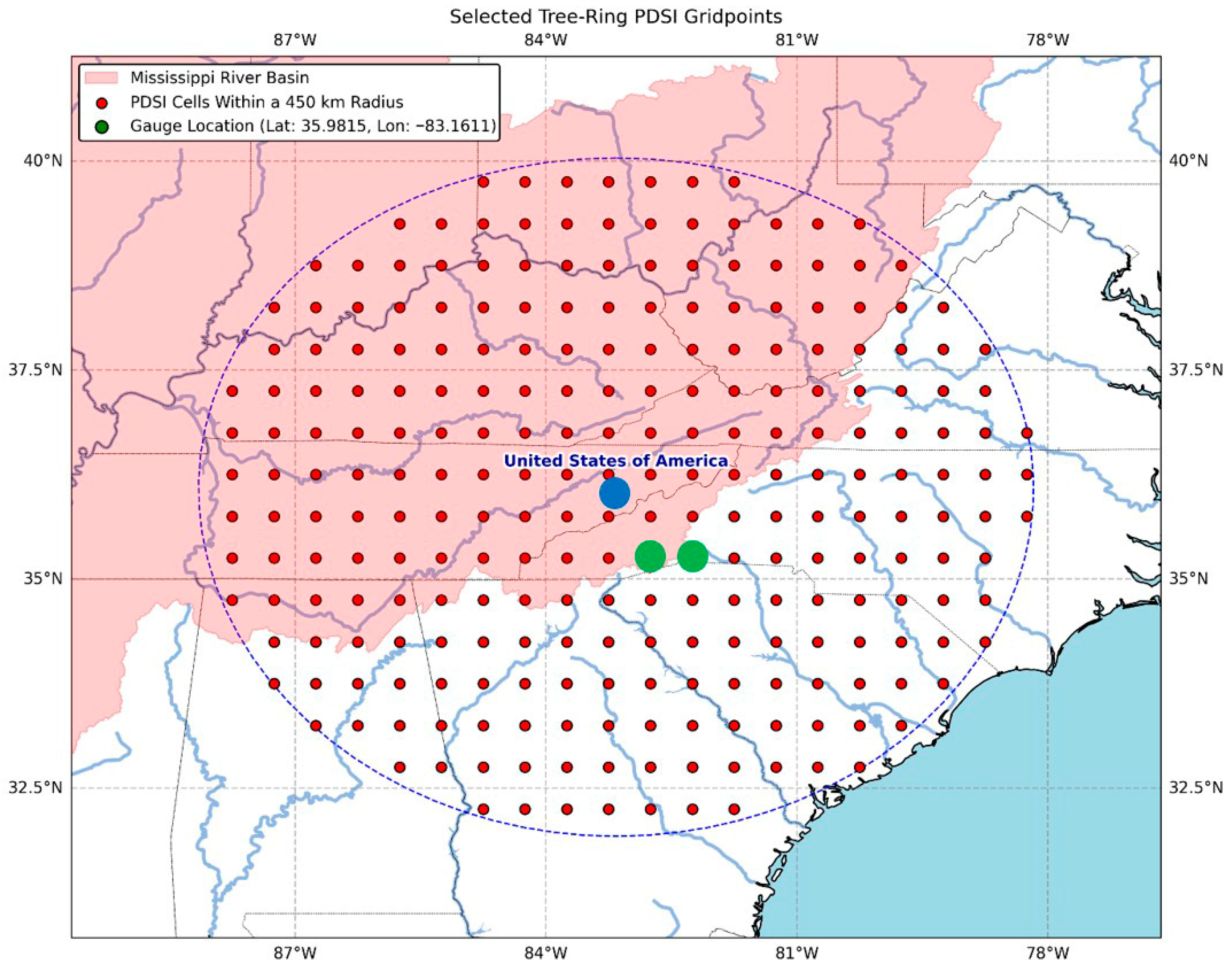

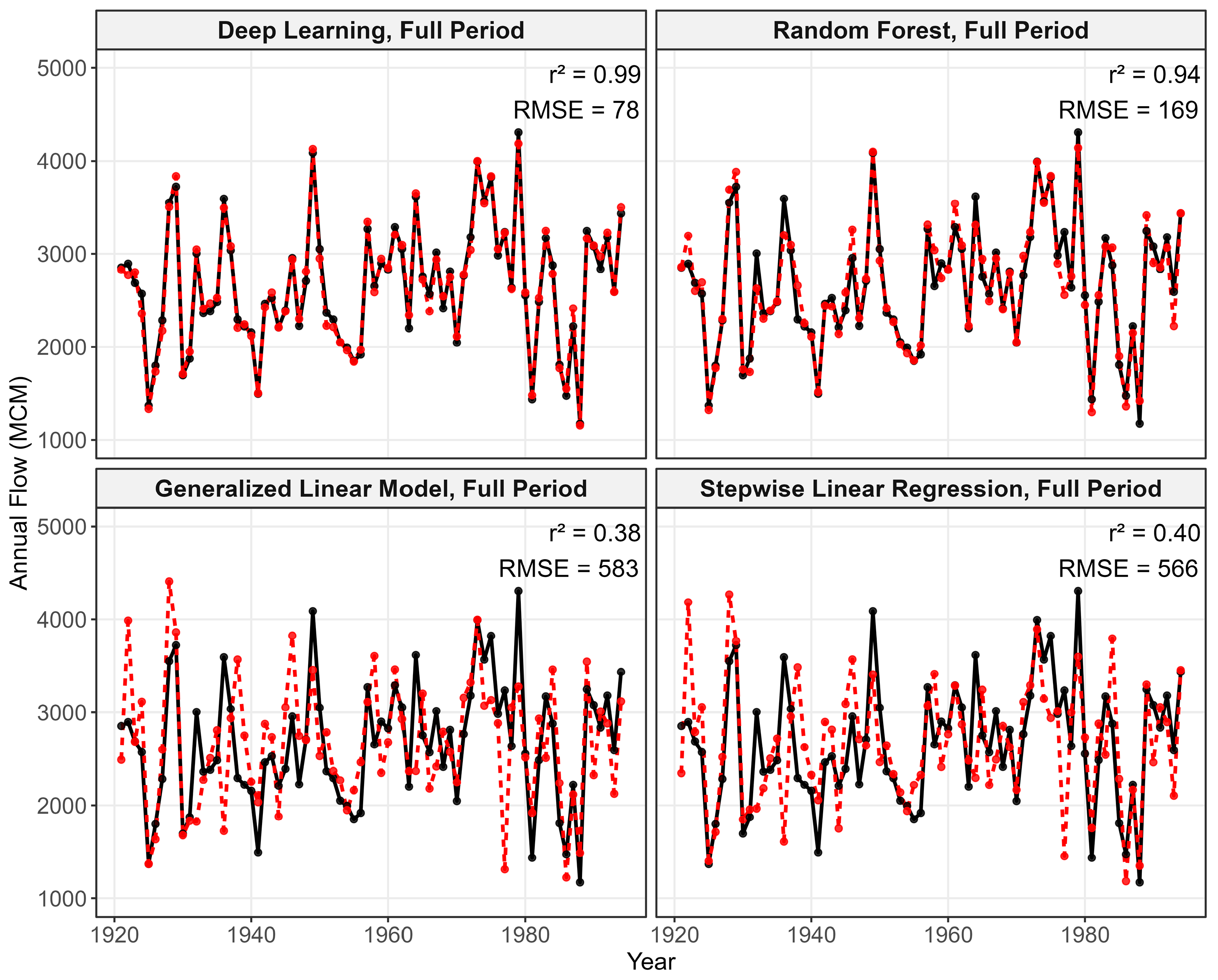
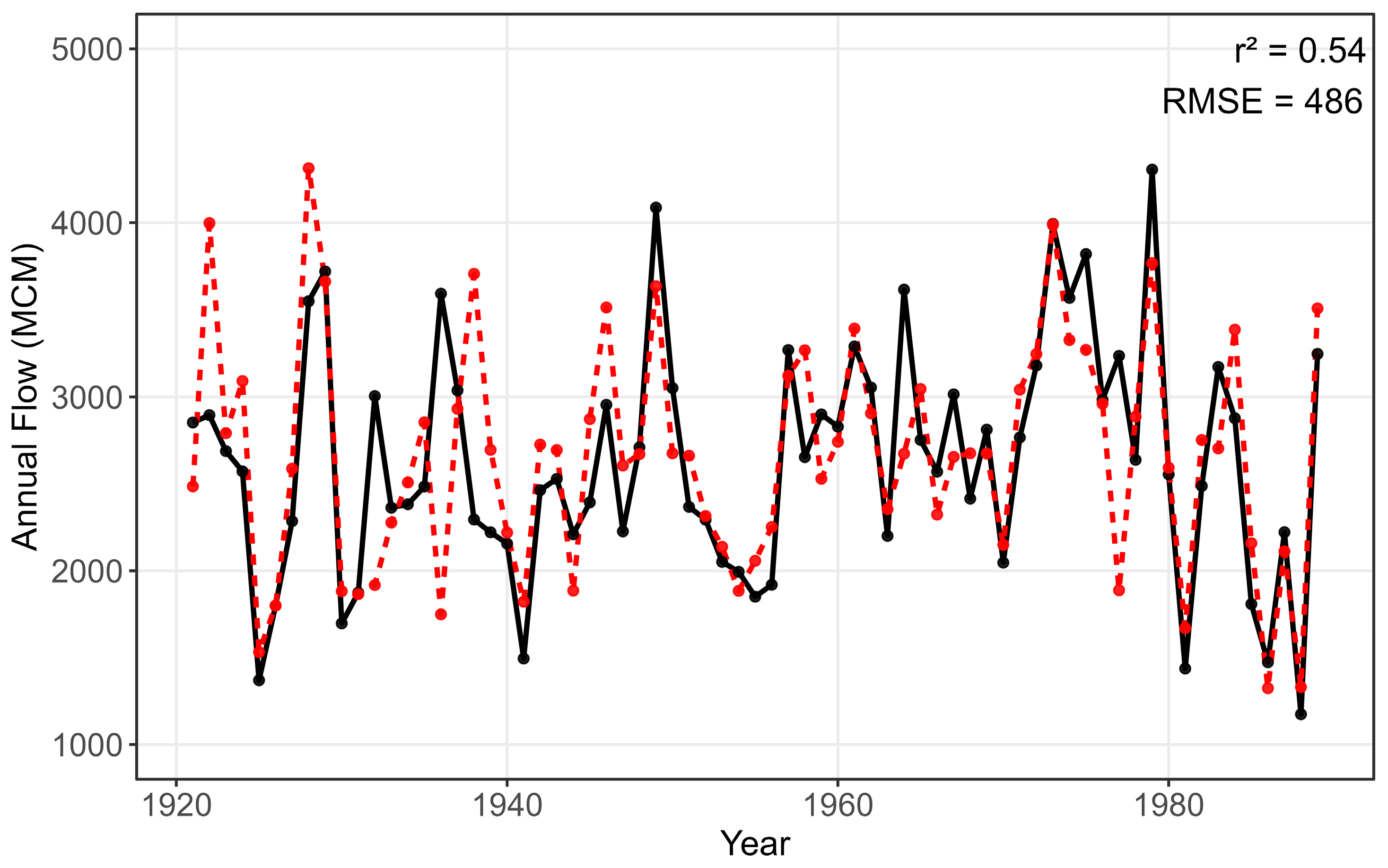
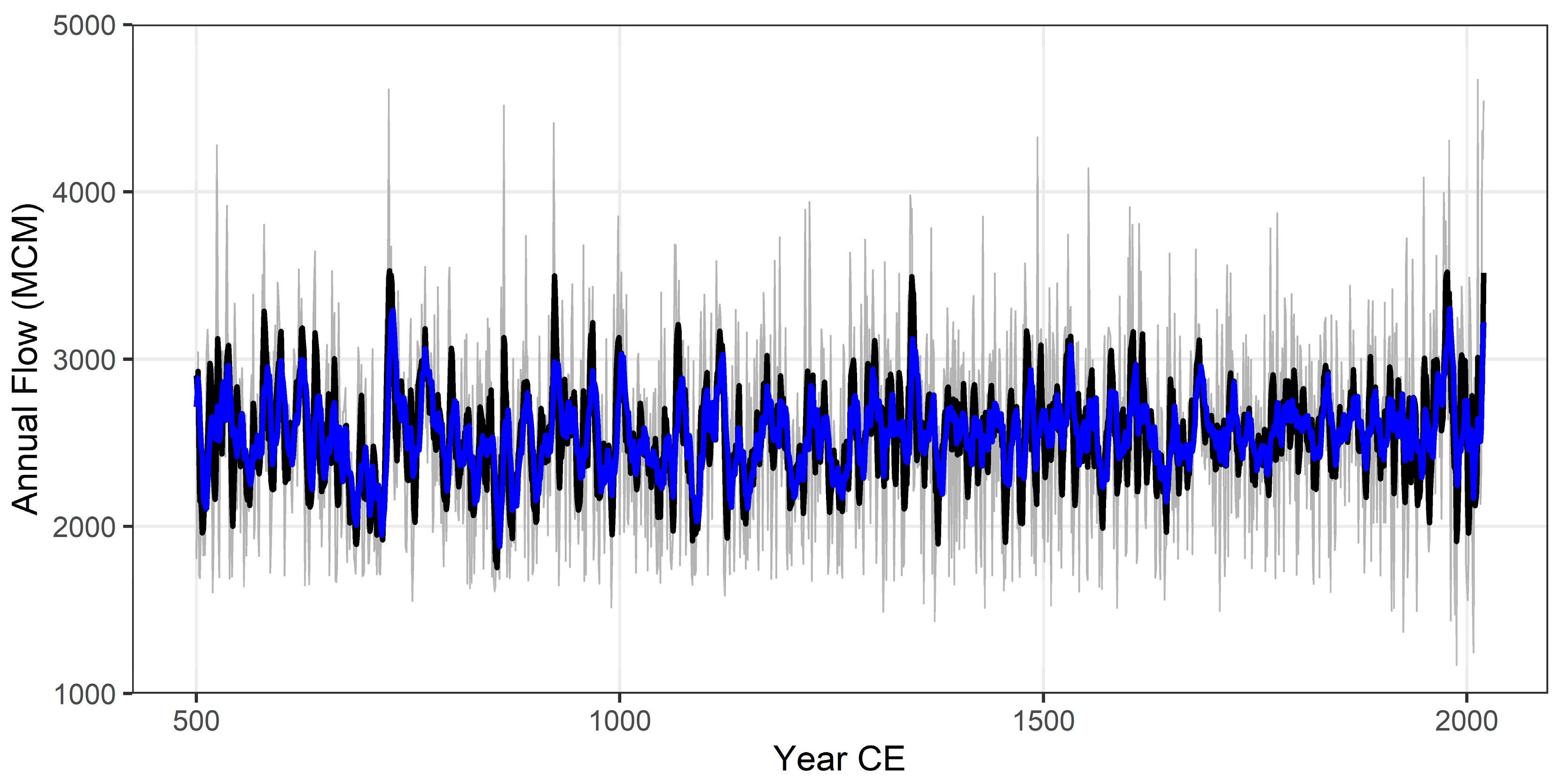
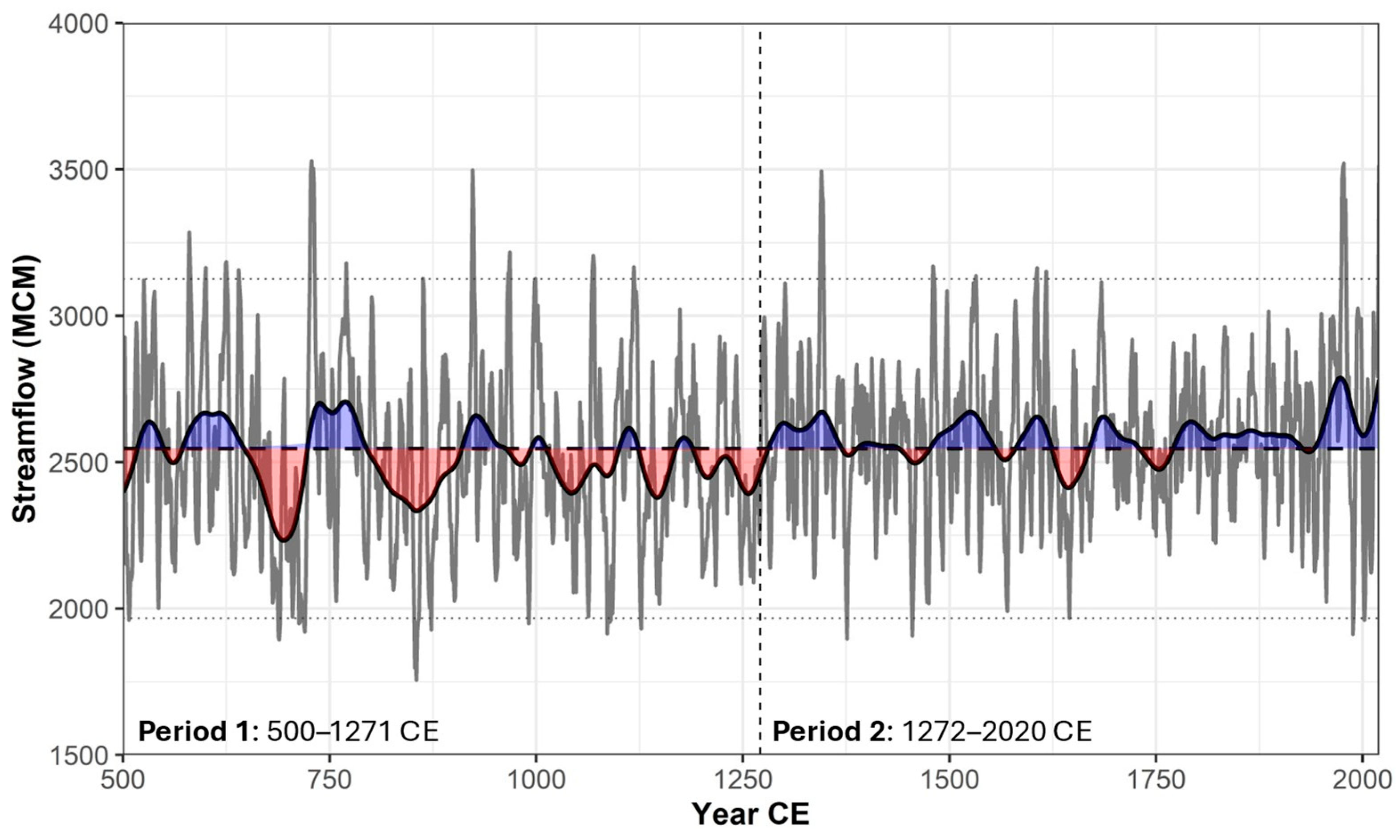
| Model | R2 | R2- Predicted | RMSE | VIF | Durbin–Watson | Sign Test |
|---|---|---|---|---|---|---|
| Stepwise Linear Regression, calibrated over 1921–1994 | 0.40 (0.40) | 0.36 | 510 (566) | 1 | 1.9 | 33/41 |
| Stepwise Linear Regression, calibrated over 1940–1989 | 0.47 (0.48) | 0.41 | 501 (516) | 1 | 2.1 | 23/27 |
| Model | Calibration R2 | Validation r2 | % of Reduced Skill |
|---|---|---|---|
| Deep Learning, 50-yr | 0.99 | 0.24 | 76 |
| Random Forest, 50-yr | 0.93 | 0.26 | 72 |
| Generalized Linear Model, 50-yr | 0.44 | 0.31 | 29 |
| Stepwise Linear Regression, 50-yr | 0.47 | 0.27 | 42 |
| Model Ensemble | 0.70 | 0.30 | 57 |
| Model | Min. R2 | Min. RMSE | Maxima R2 | Max. RMSE |
|---|---|---|---|---|
| Deep Learning, 50-yr | 0.549 | 235 | 0.387 | 433 |
| Random Forest, 50-yr | 0.696 | 164 | 0.314 | 533 |
| Generalized Linear Model, 50-yr | 0.52 | 266 | 0.054 | 1001 |
| Stepwise Linear Regression, 50-yr | 0.634 | 283 | 0.088 | 912 |
| Deep Learning, Full Period | 0.976 | 44 | 0.955 | 74 |
| Random Forest, Full Period | 0.88 | 98 | 0.678 | 235 |
| Generalized Linear Model, Full Period | 0.52 | 305 | 0.069 | 867 |
| Stepwise Linear Regression, Full Period | 0.615 | 278 | 0.097 | 845 |
| Ensemble | 0.753 | 196 | 0.143 | 739 |
| Rank | Year (CE) | Flow (MCM) |
|---|---|---|
| 1 | 855 | 1756 |
| 2 | 853 | 1797 |
| 3 | 854 | 1856 |
| 4 | 689 | 1894 |
| 5 | 1376 | 1897 |
| 6 | 688 | 1904 |
| 7 | 1455 | 1907 |
| 8 | 1988 | 1911 |
| 9 | 1086 | 1914 |
| 10 | 720 | 1921 |
Disclaimer/Publisher’s Note: The statements, opinions and data contained in all publications are solely those of the individual author(s) and contributor(s) and not of MDPI and/or the editor(s). MDPI and/or the editor(s) disclaim responsibility for any injury to people or property resulting from any ideas, methods, instructions or products referred to in the content. |
© 2025 by the authors. Licensee MDPI, Basel, Switzerland. This article is an open access article distributed under the terms and conditions of the Creative Commons Attribution (CC BY) license (https://creativecommons.org/licenses/by/4.0/).
Share and Cite
Lombardi, R.; Ramírez Molina, A.A.; Tootle, G. Testing Machine Learning and Traditional Models for Tree-Ring-Based scPDSI Streamflow Reconstruction: A 1500-Year Record of the French Broad River, Tennessee, USA. Water 2025, 17, 3288. https://doi.org/10.3390/w17223288
Lombardi R, Ramírez Molina AA, Tootle G. Testing Machine Learning and Traditional Models for Tree-Ring-Based scPDSI Streamflow Reconstruction: A 1500-Year Record of the French Broad River, Tennessee, USA. Water. 2025; 17(22):3288. https://doi.org/10.3390/w17223288
Chicago/Turabian StyleLombardi, Ray, Abel Andrés Ramírez Molina, and Glenn Tootle. 2025. "Testing Machine Learning and Traditional Models for Tree-Ring-Based scPDSI Streamflow Reconstruction: A 1500-Year Record of the French Broad River, Tennessee, USA" Water 17, no. 22: 3288. https://doi.org/10.3390/w17223288
APA StyleLombardi, R., Ramírez Molina, A. A., & Tootle, G. (2025). Testing Machine Learning and Traditional Models for Tree-Ring-Based scPDSI Streamflow Reconstruction: A 1500-Year Record of the French Broad River, Tennessee, USA. Water, 17(22), 3288. https://doi.org/10.3390/w17223288








